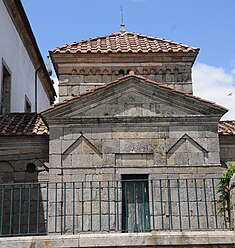Saint Frutuoso Chapel
| Chapel of São Frutuoso (Capela de São Frutuoso) | |
| Chapel of São Salvador de Montélios | |
| Chapel (Capela) | |
|
The front façade of the Romanesque chapel of São Frutuoso alongside of the Church of São Salvador
|
|
| Official name: Capela de São Frutuoso de Montélios | |
| Named for: Fructuosus of Braga, Bishop of Braga | |
| Country | |
|---|---|
| Region | Norte |
| Subregion | Cávado |
| District | Braga |
| Municipality | Braga |
| Location | Real |
| - elevation | 75 m (246 ft) |
| - coordinates | 41°33′37.32″N 8°26′19.47″W / 41.5603667°N 8.4387417°WCoordinates: 41°33′37.32″N 8°26′19.47″W / 41.5603667°N 8.4387417°W |
| Length | 9.25 m (30 ft), West-East |
| Width | 13.0 m (43 ft), North-South |
| Architects | Fructuosus of Braga, João de Moura Coutinho e Sousa Lobo |
| Style | Visigothic |
| Materials | Granite, Limestone, Marble, Chestnut, Tile |
| Origin | 560 A.D. |
| - Initiated | 656 A.D. |
| - Completion | 665 A.D. |
| Owner | Portuguese Republic |
| For public | Public |
| Visitation | Closed (Mondays, Tuesday mornings, every weekend of each month, and on 1 January, Easter Sunday, 1 May and 25 December) |
| Easiest access | E.N.201 to Braga, in the direction of Ponte de Lima; locality of Lugar da Igreja or Montélios |
| Management | Instituto Gestão do Patrimonio Arquitectónico e Arqueológico |
| Operator | Roman Catholic Archdiocese of Braga |
| Summer | 9:30 a.m.-12:30 p.m.h; 2:00 p.m.-5:30 p.m. |
| Winter | 9:30 a.m.-12:30 p.m.h; 2:00 p.m.-5:00 p.m. |
| Status | National Monument |
| Listing | Decree 33/587; DG63, 27 March 1944 |
The Chapel of São Frutuoso (Portuguese: Capela de São Frutuoso), also known as the Chapel of São Frutuoso of Montélios (Portuguese: Capela de São Frutuoso de Montélios) or the Chapel of São Salvador of Montélios (Portuguese: Capela de São Salvador de Montélios), is a pre-Romanesque chapel in the civil parish of Real, municipality of Braga. It is part of group of religious buildings that include the Royal Church, and originally built by the Visigoths in the 7th century, in the form of a Greek cross. Since 1944, it has been classified as a National Monument (Portuguese: Monumento Nacional).
Based on historical accounts, and oral tradition, the site of the chapel was (around 560 A.D.) the location of a small Roman villa and, likely, a temple dedicated to the god Asclepius.
In 656, Fructuosus of Braga, then Bishop of Bracara, founded on this site the Monastery of São Salvador, ordering the construction of the chapel, as his tomb. In the biography of his life, São Valerius confirms as much, mentioning that the saint who founded the convent was buried there (between 665 and 666).
In the 9th-10th century, the chapel was reconstructed and redecorated. From a document dated in 883, the chapel was reconsecrated to São Salvador, also affirming the original construction to between 656 and 665.
Around the 12th century, following the Reconquista from the Arabs, with the revival of the Christian community and affinity for Saint Frutuoso of Braga, a cult to the saint was begun. In 1102, the Archbishop of Santiago de Compostela, D. Diogo Gelmires, transferred the mortal remains of Frutuoso to Compostela.
...
Wikipedia

